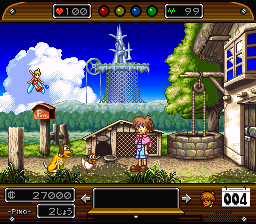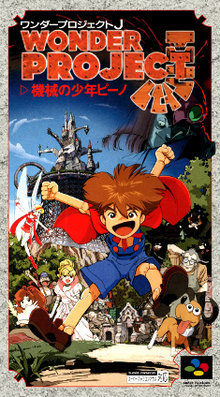|
Wonder Project J
Wonder Project J[b] is a 1994 life simulation video game developed by Almanic Corporation and published by Enix for the Super Famicom. In the game, players take care of a boy Gijin (robot) created by Dr. Geppetto named Pino. Directed by Takashi Yoneda, the title was created by most of the same personnel that worked on previous projects at Almanic such as E.V.O.: Search for Eden. It was met with positive reception from critics and sold over 1.3 million copies in Japan, making it one of the best-selling Super Famicom games. A sequel, Wonder Project J2, was released in 1996 for the Nintendo 64. Gameplay Wonder Project J is a life simulation game in which the player raises a Pinocchio-esque boy named Pino, who displays a very large amount of animations to make him appear more human to the player.[2][3][4][5][6] The game uses Pino's fairy companion Tinker as a point and click interface like an adventure game, with the main goal being educate Pino to make him more human, which can be accomplished by scolding him when he does something wrong and praising him when he does something right.[2][5][6] The player collects a variety of items through the adventure. Some are used to train various parameters of his character (strength, kindness, etc.), some are consumables which instantly adjust his various character parameters (giving him pudding will increase his trust, batteries increase his health, etc.), while others are used to teach him certain behaviours (sowing seeds, fighting with a sword, etc.). Pino needs to succeed in various challenges and confrontations to activate various virtue circuits to finally activate “Circuit J”. These tasks are accomplished based on various parameters of his character (is he strong enough, does he have enough luck, etc.) The purpose of the final circuit is to help with his final task to foster relations between humans and the robot-like Gijin. Pino has two health bars. One is physical health while the other is mental health. Physical tasks (like climbing up a rope) or getting hurt physically reduces physical health, while mental tasks (like reading a book) or getting feelings hurt reduces mental health. Some tasks may reduce both health bars. Pino may sleep in order to restore his health in exchange for a small amount of money and the passing of one day. The day counter does not affect the game, except for certain tasks like farming and setting out to sea. Upon finishing the game, Dr. Geppetto and Tinker encourage the player to play the game again, finishing each act within a certain amount of days, in order to get the secret ending. Synopsis
Development and releaseWonder Project J was developed by Almanic Corporation, which also developed E.V.O.: Search for Eden, in conjunction with Mint and Omnibus Promotion.[1][7][8] Takashi Yoneda served as the project's director, as well as designer and writer.[1][7] Hiroki Fujimoto also served as producer.[9] Yoneda recalled on his personal website that he had a difficult time understanding the concept of communicating with a character via a point and click interface, however he succeeded in realizing the game due to cooperation with late anime director Umanosuke Iida.[1][7] Yoneda stated he used both Sekai Meisaku Gekijō and works from Toei Animation as models for world building.[7] Yoneda has since regarded the title as "the most thoughtful and deep work" for him.[7] Japanese animator Toshihiro Kawamoto also worked as artist for the game and also illustrated the cover art.[1][10][11] Wonder Project J was first released for the Super Famicom by Enix in Japan on 4 December 1994.[12] An official strategy guide was also released in Japan by Enix.[13] Because the game was never published outside Japan, a fan translation was released in 2001.[14] ReceptionReception
In April 1995, Famitsu's "Reader Cross Review" section gave Wonder Project J a 7 out of 10.[18] The game was a commercial hit, with sales of 1.3 million units in Japan alone.[19] Hardcore Gamer gave the title a positive retrospective outlook.[20] In 2011, 1UP.com's Bob Mackey listed it among the "Six Must-Play Super Nintendo Imports".[10] SequelA sequel, Wonder Project J2, was developed by Givro Corporation (previously Almanic Corp.) and released by Enix for the Nintendo 64 in 1996, serving as one of the last projects by Givro prior to their dissolution in 1998.[7][8][21][22] The sequel was later re-released by Square Enix as a two-part download for mobile phones in Japan in 2010.[22][23][24] NotesReferences
External links |
||||||||||||||||||||||||||||||||||||||||||
